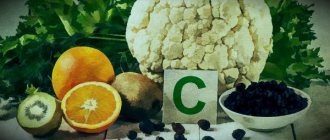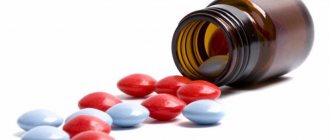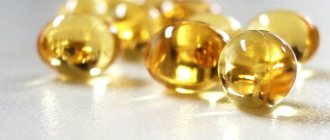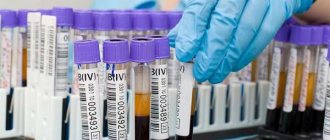Everyone has heard about the benefits of vitamin C or ascorbic acid, but most people do not even suspect that this l-isomer of ascorbic acid can also cause harm. Moreover, some daredevils resort to extreme shock dose treatment.
So is there an overdose of vitamin C and can you be poisoned by it? When does taking it additionally help a person, and what doses will cause dangerous consequences? And how to remove vitamin C from the body in case of excess?
Benefits of Vitamin C
Even schoolchildren know that a lack of this substance in the body leads to disruptions in the functioning of various organs and systems. After all, vitamin C is extremely important for maintaining normal metabolism. The human body cannot produce this substance on its own. Therefore, people are forced to get vitamin C from food (vegetables, fruits).
This substance has the following beneficial properties:
- Supports normal carbohydrate metabolism in the body.
- Helps improve intracellular metabolism.
- Stimulates the production of essential hormones.
- Helps the body absorb other vitamins.
- Strengthens bones and teeth.
- Increases the body's resistance to various infections.
But despite all these beneficial qualities, this substance should not be abused. It must be remembered that vitamin C in excess can harm health and even provoke intoxication.
WHAT IS HYPERVITAMINOSIS?
From the name it is clear that hypervitaminosis is a condition in which the body receives too many vitamins and it cannot cope with them.
Vitamins are super active substances. They help enhance certain physiological processes, the production, breakdown or absorption of certain substances, proteins, fats and microelements. Some vitamins, such as A and D, are so active that their effects are similar to those of hormones. Therefore, the body requires them in very small quantities. In excess, vitamins can so unbalance all body systems that a long and difficult recovery will be required.
In this case, vitamins are not synthesized in the human body, but come from outside. Without them, all chemical processes will be inhibited. This is what can explain spring lethargy, fatigue, and drowsiness.
When is it recommended to use ascorbic acid?
This product is an artificial source of vitamin C. It is important to use this substance correctly, because its excess can cause harm rather than benefit. Before you start taking vitamin C (dragées), the instructions for use should be carefully studied.
First of all, you need to decide to whom this remedy is recommended.
So, you need to take ascorbic acid in the following cases:
- Presence of alcohol or nicotine addiction.
- Physical overexertion.
- Living in an area with an unfavorable climate.
- Puberty.
- Infections.
- Rehabilitation after serious illnesses.
- Period of use of hormonal contraceptives.
- Intoxication.
In the presence of the above conditions, vitamin C (dragees) is used in a dose of 500 milligrams. However, you should not self-medicate, because the remedy is not as harmless as it seems. To avoid taking too much vitamin C, you should consult your doctor before starting to take it.
Permissible dosage
Any remedy must be taken correctly, and vitamin C (dragées) is no exception. The instructions for use say that ascorbic acid is best consumed after meals, in which case it is well absorbed by the body. The optimal dosage of the substance for adults varies from fifty to one hundred milligrams per day. In childhood, the maximum amount is 75 mg per day. During the period of bearing a child and breastfeeding, you should consume from 75 milligrams of ascorbic acid for ten to fifteen days. Then the dose should be increased to 100 mg. However, it must be remembered that for some, taking ascorbic acid can cause side effects, such as inflammation of the mucous membranes of the stomach and intestines, as well as hypertension. But even if a person does not experience these symptoms, he needs to strictly adhere to the doctor’s recommendations for the use of vitamin C. An excess of the substance leads to disruptions in the functioning of various organs.
Vitamin D preparations
Vitamin preparations are sold cheaply in our network of pharmacies. Vitamin D enters the human body from the liver of fatty sea fish, cow's milk, butter, and egg yolks. Under the influence of ultraviolet rays, cholecalciferol is formed in the skin.
Vitamin D is absorbed first in the lymphatic vessels, after which it enters the liver. The element accumulates in the bones, liver, and small intestines. Moreover, the body also releases the vitamin with bile into the intestines, where some of the element is reabsorbed. Excretion occurs in feces and urine. Ergocalciferol remains in the body for approximately 42 days.
Vitamin D, when ingested by the body, improves the absorption of phosphorus and calcium in the gastrointestinal tract. These elements are more easily transferred to bone tissue and stored in it. Indications for the use of vitamin D preparations are the following:
- Vitamin deficiency of element D,
- Prevention and therapy of rickets,
- Recovery period after bone fractures,
- Some bone and joint diseases
- Caries,
- Skin diseases,
- Problems in the functionality of the parathyroid glands.
The drugs are often used in the treatment of tuberculosis (in its inactive form), psoriasis, and lupus. Contraindications for use are heart failure, kidney and liver diseases, ulcerative lesions of the stomach and duodenum, atherosclerosis, and the elderly. In case of overdose and hypervitaminosis, stop taking the drugs and prescribe drugs that accelerate its transformation and removal from the body.
Products containing vitamin C
Ascorbic acid should be consumed as an additional source of a substance important for the body. However, the bulk of vitamin C must be obtained from food. So what foods contain this substance? These are the following products:
- Cabbage.
- Berries: cranberries, currants, rose hips.
- Citrus fruits (grapefruits, lemons, tangerines, oranges).
- Parsley.
- Tomatoes.
- Bell pepper.
- Kiwi.
When consuming these foods, you must be careful to avoid such a phenomenon as an overdose of vitamin C.
Doctors recommend eating these fruits and vegetables in the following quantities:
- One orange.
- 1 bell pepper.
- 2 medium sized tomatoes.
- Black currants (twenty pieces).
- One hundred to two hundred grams of cabbage.
- Kiwi (1 piece).
This is a daily norm that is important to strictly adhere to. It should be remembered that during freezing and heat treatment, a significant proportion of the vitamin is still preserved.
For whom can this substance be dangerous?
Despite all the beneficial properties of vitamin C, there are diseases and situations in which it must be used with extreme caution. These are the following states:
- Presence of stones in the genitourinary system.
- Diabetes.
- Pregnancy and lactation period.
If these conditions exist, you should use the product only after consultation with a specialist.
Many parents who are concerned about the health of their child and strengthening his immunity give him ascorbic acid. However, its independent use can lead to an overdose of vitamin C. And it, in turn, is dangerous for the development of diabetes in childhood. During pregnancy, hypervitaminosis can lead to spontaneous abortion. Sometimes women who abuse vitamin C give birth to children with developmental defects.
Who should not take ascorbic acid?
Despite the enormous benefits of ascorbic acid, there are groups of people who should not take it. These include:
- those who suffer from impaired functioning of the renal system;
- people diagnosed with diabetes mellitus;
- those who adhere to a “salty” diet”;
- pregnant women;
- people suffering from a constant increase in blood pressure;
- those who are diagnosed with cataracts;
- those who have a tendency to thrombosis.
It is important to consult a specialist before starting to take ascorbic acid. This especially applies to pregnant and lactating women, as well as children. It is known that people suffering from nicotine or alcohol addiction not only need to adjust their diet, but also take pharmaceutical medications, since their body does not have “acidic” vitamins at all.
Is it possible to overdose?
Despite the fact that ascorbic acid is available without a doctor's prescription, if used incorrectly it can lead to very sad consequences.
Vitamin C dissolves in water and is excreted from the body through the kidneys. However, if consumed in excess, the substance can lead to intoxication. This is most likely in the following situations:
- Use of ascorbic acid to prevent diseases (for example, during epidemics).
- During infections, when the patient does not follow the doctor's instructions for the use of vitamin C, an overabundance is also possible.
- If you consume ascorbic acid in your diet, there are many foods high in this substance.
- Accidental ingestion of large amounts of the drug by children.
- With the simultaneous use of ascorbic acid and other vitamin supplements.
Vitamins in our lives and when the need for them increases
The basis of life
Health is the basis of our entire life. With good health, you can easily solve any problems and overcome all difficulties.
Only a healthy person can be happy and successful. And only a happy person can make his loved ones happy. Nature has endowed you with a body that in itself is a miracle. There is no need to constantly test his strength; rather, help him be strong and resilient. Learn to truly take care of your body. And no matter what state your body is in at a given time, you can change the situation for the better, no matter how old you are - 8 or 80.
The organs of the human body consist of microscopic cells that contain all the chemical elements necessary for the body. In the process of human life, cells constantly form and die. In order for them to recover, a person needs living organic food containing a large amount of mineral salts and substances.
- Currently, about 13 vitamins , which, together with proteins, fats and carbohydrates, must be present in the diet of people and animals to ensure the normal functioning of vitamins.
- In addition, there is a group of vitamin-like substances that have all the properties of vitamins, but are not strictly necessary components of food.
- Compounds that are not vitamins, but can serve as precursors for their formation in the body, are called provitamins . These include, for example, carotenes, which are broken down in the body to form vitamin A, and some sterols (ergosterol, 7-dehydrocholesterol, etc.), which are converted into vitamin D.
A number of vitamins are represented not by one, but by several compounds that have similar biological activity (vitamers), for example, vitamin B6 includes pyridoxine, pyridoxal and pyridoxamine. To designate such groups of related compounds, the word “vitamin” is used with letter designations (vitamin A, vitamin E, etc.).
Individual compounds with vitamin activity are given rational names that reflect their chemical nature, such as retinal (the aldehyde form of vitamin A), ergocalciferol, and cholecaldiferol (forms of vitamin D).
Thus, along with
- fats,
- proteins,
- carbohydrates and
- mineral salts,
the necessary complex for maintaining human life includes a fifth component of equal importance -
- vitamins.
Vitamins take a direct and active part in all metabolic processes of the body, and are also part of many enzymes, acting as catalysts.
For the body to function properly, a certain balance and compatibility of all micronutrients is necessary. This is especially important to know if you take vitamin complexes or dietary supplements. Not all combinations are equally beneficial, for example, a negative interaction is obtained when combining vitamins B12 with vitamins A, B3, B1, C, E, as well as with Copper, Iron and Manganese. Some combinations make it pointless to use the drug at all, for example, due to the reaction of vitamins C and B12 with each other, B12 is practically not absorbed by the human body.
Avitaminosis
Vitamin deficiency (avitaminosis) is a health disorder that is caused by a low content of vitamins.
Vitamins enter our body with food (as nature intended). This means that in order for vitamins to perform their “tasks,” the nutrition must be of high quality and the body’s condition must be satisfactory.
Nowadays, people most often eat monotonous, refined, highly purified foods - white bread, polished rice, pasta and confectionery, sugar, semolina, refined sunflower oil, etc. Those who think that if they eat vegetables are wrong and fruits, then there should be no problems with vitamins. Undoubtedly, plants are storehouses of valuable food components. But vitamins A, D, B12 are found in animal products. In addition, some fruits, such as bananas, are low in vitamins. A sharp decrease in the content of vitamins in products, up to complete disappearance, can be caused by
- improper storage,
- transportation,
- culinary processing.
But it happens that the content of vitamins in food corresponds to the norms, but the signs of hypovitaminosis persist. What is the reason? Most often, it is due to insufficient intake of other nutrients.
- Vitamins are consumed in the process of assimilation and metabolism of proteins, carbohydrates and fats. Therefore, with a predominantly carbohydrate diet (porridge, pasta, bread, sugar, confectionery), the need for vitamin B1 (thiamine) increases; with an excess amount of protein in food (meat, fish, eggs), the need for vitamins B6 (pyridoxine) and B2 (riboflavin) increases. ).
- Vitamins require other nutrients to be absorbed and transported For example, the absence of fats in the diet makes it impossible for the normal metabolism of fat-soluble vitamins; zinc is necessary to activate vitamin A, etc.
- Vitamins in the body perform their functions as part of enzyme complexes along with proteins and minerals! Therefore, the lack of complete proteins and minerals (iron, copper, calcium, cobalt, etc.) can cause vitamin deficiency.
- A number of foods contain antivitamins - substances that destroy vitamins or reduce their activity in the body .
- For example, raw fish contains the enzyme thiaminase, which decomposes vitamin B1;
- ascorbic acid in almost all products is accompanied by the enzyme ascorbinase;
- corn contains indole-3-acetic acid, which destroys vitamin PP.
- Lipokidase is an enzyme present in some fats that helps break down carotene. It is also found in soybeans.
- Avidin, found in the whites of raw chicken goose and duck eggs, blocks biotin.
- Medicinal substances often reduce the effectiveness of vitamins.
With normal vitamin content and a well-balanced, varied diet, vitamin deficiency can develop due to an increased need for vitamins and impaired absorption.
The need for vitamins increases:
- during the period of growth, under any stress,
- great physical and neuropsychic stress,
- during the period of acclimatization.
- Vitamins are consumed in large quantities during diseases.
- Some vitamins can be rapidly excreted from the body when taking large doses of another vitamin.
- Many microbes that cause infectious diseases can destroy vitamins. For example, the tuberculosis bacillus and the causative agent of Flexner's dysentery secrete the enzyme thiaminase, which can result in hypovitaminosis B1 without a lack of this vitamin in food.
- Intestinal inhabitants unusual for humans (worms, bacteria, yeast, etc.) can use vitamins contained in the body in increased quantities.
For the absorption of a number of vitamins and their transformation into active forms, the condition of the mucous membrane of the small intestine is of utmost importance. This is where most vitamins are absorbed. Thus,
- any disruption of the small intestine leads to an imbalance of vitamins in the body and can eventually lead to hypovitaminosis.
Colon diseases also negatively affect vitamin metabolism. It is known that some vitamins are produced by microbes that live in the large intestine.
Vitamin deficiency can occur when the amount of food, and therefore vitamins, is reduced due to poor appetite and vomiting. In conclusion, I would like to note that the imbalance of vitamin balance is more noticeable the more severe the disease and the longer it lasts.
Hypervitaminosis
You should not think that the balance of microelements is always negative. The prevalence of excess chemical elements is 1/6 of dismicroelementoses. Russians have quite common excesses of not only toxic lead, cadmium and aluminum, but also excesses of iron, vanadium, nickel, chromium, molybdenum, boron, and even zinc, selenium and iodine - elements included in many vitamin and mineral complexes. These vital microelements, which are vital in negligible quantities, when introduced into the human body in excess, become toxic, can provoke serious diseases, and therefore can cause much more harm to the body than their deficiency.
When does hypervitaminosis replace vitamin deficiency?
Not everyone knows that in fact vitamins (and about a dozen of them are known) are divided into two groups:
- fat soluble (A, D, E, F and K)
- and water-soluble (all others).
This division does not have much chemical meaning (each of the groups unites very dissimilar substances), but physiologically it is justified, since it reflects the differences in the behavior of these substances in our body .
Fat-soluble vitamins can be stored in significant quantities in the adipose tissue of our body. But you won’t be able to “eat enough” for future use with water-soluble vitamins : they are not stored and any amount of them is very quickly eliminated from the body. This explains why, on the one hand, hypovitaminosis of water-soluble vitamins is quite common, and on the other hand, hypervitaminosis of fat-soluble vitamins is sometimes observed.
For example, you tanned perfectly during your vacation in the southern sun for 7-10 days, so you can afford to not think about vitamin D deficiency for the whole year. But if after your vacation you decide to “drink vitamins” and buy a drug that, among other things, will contain the fat-soluble vitamin you have already received in the required dose, then expect hypervitaminosis . And you definitely won’t like him! The same applies to everyone’s favorite vitamin A (the main fighter against aging). In an amount of 1000 mg (for adults), the body definitely needs it, but in excess it can cause a lot of unpleasant phenomena. And in chronic form, vitamin A hypervitaminosis can lead to the most severe consequences.
The other extreme is to take water-soluble vitamins in a burst course. Which of us was not once recommended to drink ascorbic acid (vitamin C) in huge doses before the cold season? Only now we know that such a measure is useless. Our body needs vitamin C constantly! It doesn't accumulate. And no matter how much you drink, the body will only take as much as it needs for one day, and the rest will be eliminated naturally. There will be no benefit beyond measure, but you will get an allergic reaction to the acid.
In any case, it is better not to experiment and take vitamins in strictly designated daily doses, especially for fat-soluble A, D, E, F and K. Hypervitaminosis is easier to avoid than to treat its consequences. After all, saturating the body with everything it needs happens quite quickly, but in order to remove the excess, it may take several months.
Before prescribing drugs containing microelements, it is advisable to know not only the initial content of chemical elements in the body, but also to imagine the interaction of microelements in the human body.
In subsequent articles you can learn about the beneficial properties of vitamins and minerals, signs of their deficiency, and interactions with other vitamins and minerals.
Signs of overdose
Unfortunately, such hypervitaminosis is sometimes difficult to recognize, since pathological phenomena do not occur immediately. An excess of vitamin C has the following symptoms:
- Lethargy.
- Dizziness.
- Diarrhea.
- Heartburn.
- Pain in the abdominal area.
- Skin rash.
- Nausea, repeated vomiting.
- Itching.
- Increased excitability.
The appearance of such symptoms in both children and adults requires immediate medical attention.
What are the risks of overdose during pregnancy?
Many pregnant women believe that “sourness” will not affect the development of the fetus or their well-being, and therefore take vitamin C almost uncontrollably. This attitude towards the use of “ascorbic acid” is very dangerous. Its consequences are the development of rebound scurvy in infants and involuntary termination of pregnancy in the early stages. The main signs of an excess of ascorbic acid in pregnant women are:
- painful cramps in the stomach;
- nausea turning into vomiting;
- deterioration of health.
In addition, in women, the body's ability to process and absorb cyanocobalamin (vitamin B12), selenium, and copper begins to decrease. At the first signs of deterioration in health, you should contact the gynecologist who is managing the pregnancy and stop taking the medications. Otherwise, negative consequences may develop.
Complications of hypervitaminosis
What are the dangers of too much vitamin C over a long period of time? The following pathological phenomena can be listed as complications of hypervitaminosis:
- Diseases of the pancreas.
- Inflammatory processes in the gastrointestinal tract, development of peptic ulcer.
- Pathologies of the genitourinary system.
- Lack of other nutrients.
- Allergic reactions that persist for a long time.
- Disorders of the monthly cycle.
- Development of hypertension.
- Spontaneous abortions.
Excess vitamin A
Symptoms:
- skin rashes;
- skin peeling;
- spurs;
- hair loss;
- drowsiness, lethargy;
- headaches and dizziness;
- lack of appetite.
Increased cholesterol and problems with the genitourinary system are a possible result.
As a treatment, you should stop taking medications that contain retinol and limit your consumption of dairy and seafood products.
The body should receive approximately 1 mg of retinol or 6 mg of carotene per day (through vitamin complexes).
Hypervitaminosis in pregnant women
During the period of bearing a child, many experts recommend ascorbic acid to women as an additional source of vitamin C. However, if the patient does not follow the doctor’s instructions and exceeds the dosage of the substance, this can lead to negative consequences. What happens when there is an excess of vitamin C in pregnant women? Typically, hypervitaminosis is accompanied by the following symptoms:
- Pain in the abdominal area.
- Nausea, vomiting.
- Weakness.
Every pregnant woman should remember that excessive consumption of vitamin C can negatively affect the condition of the unborn child. He may develop birth defects (such as heart disease) and scurvy.
Classification
Ascorbic acid is a water-soluble vitamin-like compound. It is not synthesized in the body, but has great physiological significance.
Daily norms of its consumption have been established for different categories of adult patients:
- men;
- women;
- pregnant women;
- elderly;
- with chronic diseases of internal organs;
- athletes;
- smokers.
Ascorbic acid is a powerful antioxidant shield of organic structures. It is well absorbed and easily removed through the urinary canals.
Increased intake of vitamin C is recommended for the following pathological conditions:
- bacterial and fungal infections;
- seasonal ARVI;
- burn injuries;
- helminthiasis – a parasitic disease caused by worms of the genus nematodes;
- exposure to radioactive substances;
- alcohol, chemical and drug intoxication;
- cholecystitis - inflammation of the gallbladder;
- disruption of collagen synthesis;
- chronic liver dysfunction;
- digestive disorders.
Vitamin C overdose has different symptoms in adults. They depend on the stage, prolonged use of ultra-high doses and individual reactions of the body. Ascorbic acid is involved in metabolic, biochemical and metabolic processes. Vitamin C poisoning can lead to their disruption.
Lightweight
The maximum daily intake of a water-soluble low-molecular compound is set for adults at 30-50 mg. A slight excess of this volume leads to a mild form of drug intoxication.
This stage is characterized by dyspeptic symptoms and nausea without activation of the gag reflex. Organic digestive disorders may occur.
Metabolic dysfunction is manifested by difficulties in deurination and a feeling of heaviness in the epigastric region. A mild stage of ascorbic acid overdose occurs when the following norms established for adult patients are systematically slightly exceeded:
| Patient category | Recommended dose of vitamin C, mg/day |
| Women over 19 years old | 75 |
| Men 18-50 years old | 90 |
| Elderly | 100 |
| For colds | 500-600 |
| During seasonal influenza circulation | 800-1000 |
| Pregnant | 300-400 |
| Athletes | 200-250 |
| Smokers | 1500 |
When taking vitamin supplements and a diet rich in ascorbic acid, it is not advisable to additionally use pharmaceutical preparations with this compound.
Moderate
This pathological condition occurs when the recommended therapeutic dose is regularly exceeded by 2-5 times. This volume is fraught with impaired absorption of nutrients into the systemic circulation.
This clinical picture is observed when taking more than 2000 mg of vitamin C, which is, although weak, but still an acid. There is a massive death of beneficial intestinal microflora.
This is manifested by increased pain in the epigastric region and stool disturbances. With moderate intoxication, diarrhea or constipation is possible. The immune system reacts to such a volume of physiologically active substance with allergic reactions in the form of urticaria and skin itching.
A single dose of 2000-2500 mg of vitamin C in adults usually does not lead to negative effects. Undigested excess ascorbic acid is metabolized in the kidneys and removed through the urinary tract without pathological consequences.
Regularly exceeding the recommended dose by 2-5 times radically changes the situation. Vitamin C has weak cumulative properties. When taken systematically in such volumes, its accumulation in soft tissues and smooth muscle fibers is observed.
Severe poisoning
The acute stage of drug intoxication with ascorbic acid occurs after exceeding the recommended daily dose by 10 times. It is expressed in surges in blood pressure, cardiac arrhythmia, and acute pain in the epigastric region.
Vomiting with bloody discharge is possible. This condition poses an immediate threat to life and requires the use of a complex of resuscitation measures. Such situations are extremely rare in clinical practice.
An overdose of vitamin C (symptoms in adults with a severe form) changes the rheological properties of the blood, increasing its fluidity and preventing clotting. Any bleeding can be fatal.
Vitamin C hypervitaminosis in children
The child’s body is extremely sensitive to any unfavorable factors. Therefore, an overdose of vitamins has a negative impact on children's health. Parents need to be careful when using ascorbic acid. Before giving this medicine to a child, you should consult your doctor and then strictly follow his recommendations regarding dosage.
If a child accidentally finds a package of vitamins and takes an excess amount of pills, he or she will show signs of poisoning. If such symptoms occur in children, it is necessary to urgently take measures to eliminate them.
Help with hypervitaminosis
This substance is quickly absorbed by the body. If there is an excess of vitamin C, treatment should begin with cleansing the stomach. This event must be carried out immediately to remove excess amounts of the substance from the body. In order to rinse the stomach, you need to drink about two liters of pure still water. After this procedure, the best option for assistance in case of an overdose is to call an ambulance. If medical workers refuse to take the victim to a medical facility, you must urgently ask them to do so. Since an excess of vitamin C in the body can subsequently provoke unexpected complications, the patient’s condition should be monitored in a hospital setting. Only in a hospital will he be able to provide adequate medical care if a critical situation arises.
Causes of overdose
People begin to talk about an overdose when a person takes more than 1 g of ascorbic acid per day. In the case when he takes a daily dose of the drug at one time, it is also possible that he feels worse. If the excess of the “acidic” vitamin is small, the renal system easily processes it and removes it from the body. The main reasons for the development of an overdose are:
- accidental use of large amounts of a substance, usually seen in children;
- simultaneous use of pharmaceutical drugs and food products enriched with ascorbic acid;
- constant use of vitamin C in the autumn-spring period, when a state of vitamin deficiency is often observed.
Usually people turn to a specialist for help at the moment when symptomatic manifestations become very noticeable. During this period, the overdose condition becomes chronic, and therefore requires adjustment by a specialist.
conclusions
Vitamin C is a substance that is essential for the normal functioning of all body systems. This vitamin is quickly absorbed, but is not produced in the human body on its own. It can only be obtained from food or from artificial sources (eg, ascorbic acid, special drinks). A lack of vitamin C is dangerous for the body. However, an excess of this substance can also lead to serious consequences: the formation of stones in the genitourinary system, allergies, disorders of the stomach and intestines, the development of diabetes in children, miscarriages, and serious poisoning. Therefore, those who would like to use ascorbic acid should first consult with a specialist. Only a doctor can choose an adequate dosage for a patient depending on his age and health condition. If you consume vitamin C excessively, a person needs urgent hospitalization, as this condition is extremely dangerous. If it is possible to obtain this substance naturally (from vegetables, fruits, vitamin drinks), it is better to avoid artificial sources.
What does a chronic overdose of ascorbic acid lead to?
You should not ignore the alarm bells that your body uses to signal that something is wrong with it. Chronic overdose of ascorbic acid has serious consequences. These include:
- gastritis, gastric ulcer caused by dysfunction of the gastrointestinal tract;
- disruption of the menstrual cycle;
- the occurrence of stone formations in the organs of the renal system, gall bladder;
- slowing down the process of absorption of cyanocobalamin (vitamin B12);
- damage to leukocyte cells, which is irreversible.
In children, chronic overdose “results” in diabetes mellitus and intolerance to any products that contain vitamin C.











